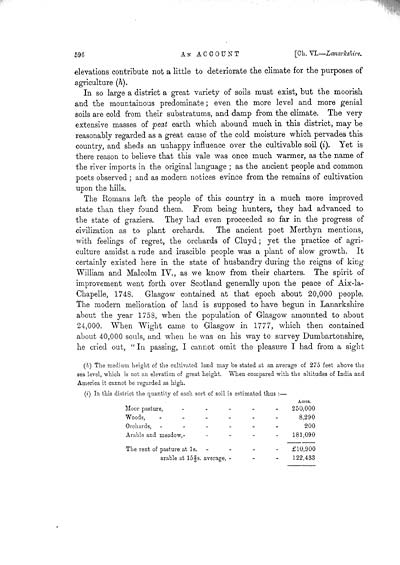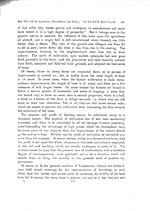Volume 6
(155) Page 596
Download files
Individual page:
Thumbnail gallery: Grid view | List view

596 elevations contribute not a little to deteriorate the climate for the purposes of agriculture (h). In so large a district a great variety of soils must exist, but the moorish and the mountainous predominate; even the more level and more genial soils are cold from their substratums, and damp from the climate. The very extensive masses of peat earth which abound much in this district, may be reasonably regarded as a great cause of the cold moisture which pervades this country, and sheds an unhappy influence over the cultivable soil (i). Yet is there reason to believe that this vale was once much warmer, as the name of the river imports in the original language ; as the ancient people and common poets observed; and as modern notices evince from the remains of cultivation upon the hills. The Romans left the people of this country in a much more improved state than they found them. From being hunters, they had advanced to the state of graziers. They had even proceeded so far in the progress of civilization as to plant orchards. The ancient poet Merthyn mentions, with feelings of regret, the orchards of Cluyd; yet the practice of agri- culture amidst a rude and irascible people was a plant of slow growth. It certainly existed here in the state of husbandry during the reigns of king William and Malcolm IV., as we know from their charters. The spirit of improvement went forth over Scotland generally upon the peace of Aix-la- Chapelle, 1748. Glasgow contained at that epoch about 20,000 people. The modern melioration of land is supposed to have begun in Lanarkshire about the year 1758, when the population of Glasgow amounted to about 24,000. When Wight came to Glasgow in 1777, which then contained about 40,000 souls, and when he was on his way to survey Dumbartonshire, he cried out, " In passing, I cannot omit the pleasure I had from a sight (h) The medium height of the cultivated land may be stated at an average of 275 feet above the sea level, which is not an elevation of great height. When compared with the altitudes of India and America it cannot be regarded as high. (i) In this district the quantity of each sort of soil is estimated thus :� Acres. Moor pasture, - 250,000 Woods, - 8,290 Orchards, - 200 Arable and meadow, - 181,090 The rent of pasture at 1s. - �10,900 arable at 15 2/3s. average, - 122,433
Set display mode to:
![]() Universal Viewer |
Universal Viewer | ![]() Mirador |
Large image | Transcription
Mirador |
Large image | Transcription
Images and transcriptions on this page, including medium image downloads, may be used under the Creative Commons Attribution 4.0 International Licence unless otherwise stated. ![]()
| Caledonia, or, An account, historical and topographic of North Britain from the most ancient to the present times > Volume 6 > (155) Page 596 |
|---|
| Permanent URL | https://digital.nls.uk/74531340 |
|---|---|
| Description | Vol. VI. |
|---|---|
| Attribution and copyright: |
|

